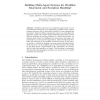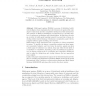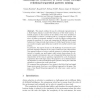137 search results - page 6 / 28 » Learning and Multiagent Reasoning for Autonomous Agents |
ATAL
2005
Springer
14 years 1 months ago
2005
Springer
Many multi-agent systems consist of a complex network of autonomous yet interdependent agents. Examples of such networked multi-agent systems include supply chains and sensor netw...
GECCO
2006
Springer
13 years 11 months ago
2006
Springer
The impact of learning on evolution in dynamic environments undergoes recognized stages of the Baldwin Effect although its cause is not clear. To identify it experimentally, we de...
ATAL
2009
Springer
13 years 8 months ago
2009
Springer
Abstract. Workflows represent the coordination requirements of various distributed operations in an organisation; workflows neatly capture business processes, and are particularly ...
LAMAS
2005
Springer
14 years 1 months ago
2005
Springer
Abstract Multi-agent systems (MASs) is an area of distributed artificial intelligence that emphasizes the joint behaviors of agents with some degree of autonomy and the complexiti...
CORR
2010
Springer
13 years 4 months ago
2010
Springer
This report outlines the use of a relational representation in a Multi-Agent domain to model the behaviour of the whole system. A desired property in this systems is the ability of...



